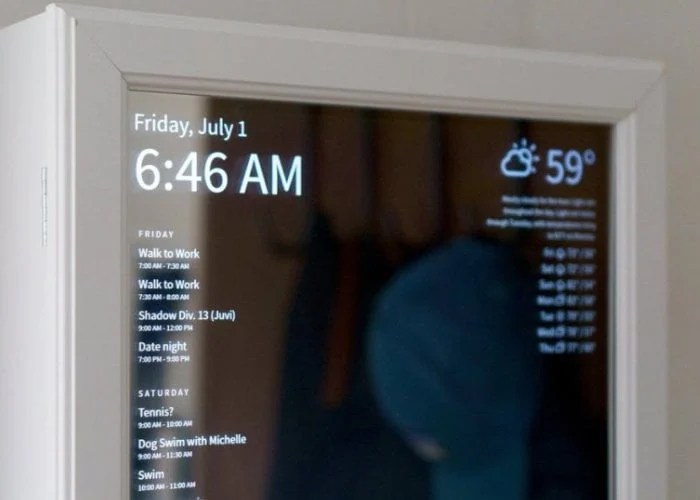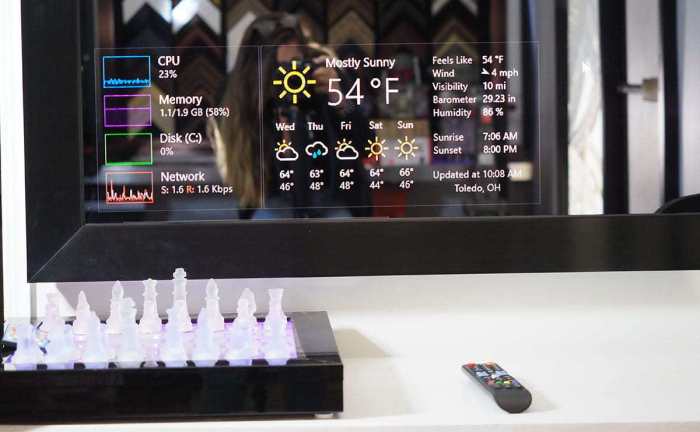DIY Smart Mirror: Imagine a mirror that’s more than just a reflection – it’s a window to a world of information, entertainment, and smart home control. Building your own DIY smart mirror is a rewarding project that combines technology, creativity, and practicality.
From displaying your schedule and weather updates to controlling your smart lights and playing music, a DIY smart mirror can be customized to fit your specific needs and preferences. It’s a fusion of hardware and software, allowing you to personalize a device that seamlessly integrates into your daily routine.
Choosing the Right Components: Diy Smart Mirror

Building a smart mirror involves selecting the right components, each playing a crucial role in the final functionality. From the display to the sensors, every element contributes to the overall performance and user experience.
Display Selection
The display is the heart of your smart mirror, and choosing the right one is essential. Consider the following factors:
- Size: The size of the display depends on the intended location and use case. For a smaller mirror in a bathroom, a 10-inch display might be sufficient. However, for a larger mirror in a living room, a 24-inch or even larger display might be more suitable.
- Resolution: Higher resolution displays offer sharper images and better clarity, especially when displaying text or intricate graphics. Aim for a display with at least 1920×1080 resolution for a good viewing experience.
- Touchscreen: A touchscreen display allows for interactive control, enabling you to navigate menus, adjust settings, and interact with the mirror directly. While not strictly necessary, a touchscreen can enhance user experience and provide more flexibility.
Recommended Raspberry Pi Models, Diy smart mirror
Raspberry Pi boards are popular choices for smart mirror projects due to their affordability, versatility, and ease of use. Here are some recommended models:
- Raspberry Pi 4: The latest Raspberry Pi model offers significant performance improvements with a quad-core processor, up to 8GB of RAM, and support for 4K displays. It’s a powerful option for demanding applications and can handle complex smart mirror functionalities.
- Raspberry Pi 3 Model B+: A more budget-friendly option, the Raspberry Pi 3 Model B+ provides a balance of performance and cost-effectiveness. It’s suitable for basic smart mirror functionality and can handle most everyday tasks.
Sensors
Sensors play a crucial role in making your smart mirror interactive and responsive to its environment. Here are some commonly used sensors:
- Motion Sensor: A motion sensor detects movement and can be used to activate the display, adjust brightness, or trigger specific actions when someone approaches the mirror. This is particularly useful for saving energy and enhancing user experience.
- Temperature Sensor: A temperature sensor can monitor the ambient temperature and display it on the mirror. This can be helpful for checking the temperature in a room or for setting a specific temperature for comfort.
- Light Sensor: A light sensor measures the ambient light level and can automatically adjust the display brightness based on the surrounding conditions. This helps to ensure optimal visibility and reduce eye strain.
Software and Programming

The heart of a smart mirror lies in the software that powers its functionality. This software interprets your commands, displays information, and manages the mirror’s interactions. There are several popular options available, each with its own strengths and weaknesses.
Popular Software Options
Popular software options for smart mirrors provide a framework for building custom interfaces and integrating various functionalities. These options often offer pre-built modules, libraries, and a community of developers who contribute to their development.
- MagicMirror²: This open-source platform is a widely used and well-documented choice for smart mirrors. It offers a modular architecture, allowing you to add and customize various modules, such as weather forecasts, calendars, news feeds, and even interactive games. Its active community provides extensive support and a wide range of modules to choose from.
- MirrorPi: This Raspberry Pi-focused platform is designed for building smart mirrors with a user-friendly interface. MirrorPi leverages the Raspberry Pi’s capabilities and provides a streamlined setup process. It includes pre-built modules for common functionalities and allows for easy integration with other Raspberry Pi projects.
Setting Up and Configuring Software
The setup and configuration process for these software options typically involves the following steps:
- Installing the Software: Download and install the chosen software on your chosen hardware platform (e.g., Raspberry Pi, computer). This often involves using package managers or following the software’s installation instructions.
- Configuring the Software: Once installed, you’ll need to configure the software to your liking. This involves customizing the display layout, adding modules, and setting up data sources for information like weather, calendars, or news.
- Testing and Debugging: After configuring the software, test the mirror’s functionality and troubleshoot any issues that may arise. This step ensures the mirror functions as intended and meets your requirements.
Customizing Mirror Functionality
The software allows you to customize the mirror’s functionality using code snippets. These snippets can be used to:
- Add New Modules: Extend the mirror’s capabilities by adding modules for specific features, such as displaying traffic information, controlling smart home devices, or playing music.
- Modify Existing Modules: Customize the appearance and behavior of existing modules, such as changing the color scheme, adding new data sources, or modifying the display layout.
- Create Custom Interactions: Implement custom interactions, such as voice commands or touch gestures, to control the mirror’s functionality.
Code Snippet Examples
- Adding a Weather Module: The following code snippet demonstrates adding a weather module using MagicMirror²:
“`javascript
“module”: “MMM-Weather”,
“position”: “top_left”,
“config”:
“appid”: “YOUR_WEATHER_API_KEY”,
“location”: “YOUR_LOCATION”,
“units”: “metric” // or “imperial”“`
Designing the Mirror’s Appearance
The visual appeal of your smart mirror is crucial. It should seamlessly blend into your surroundings while showcasing your chosen functionalities. This section will explore various design options to guide you in creating a visually stunning and functional smart mirror.Frame and Housing Design
The frame and housing play a significant role in the overall aesthetic of your smart mirror. Consider these design options:
- Minimalist Frame: Opt for a thin, sleek frame that blends discreetly with the mirror surface. This approach emphasizes the display and creates a modern, minimalist look.
- Decorative Frame: Add a touch of personality with a decorative frame that complements your decor. Choose from various materials like wood, metal, or even reclaimed materials.
- Integrated Housing: Consider integrating the display and electronics into the mirror’s back for a more seamless and concealed look. This option requires careful planning and may involve custom fabrication.
Display and Sensor Integration
Integrating the display and sensors seamlessly is crucial for a visually appealing and functional smart mirror. Consider these approaches:
- Behind-the-Mirror Display: Position the display behind the mirror’s reflective surface. This approach creates a more natural and integrated look, with the display appearing directly on the mirror’s surface.
Note: This method requires a specialized display with high transparency and brightness for optimal visibility.
- Frame-Mounted Display: Attach the display to the frame surrounding the mirror. This option offers flexibility in display size and placement, but it may create a less seamless appearance.
- Integrated Sensors: Conceal sensors within the frame or behind the mirror for a discreet and integrated look. This approach maintains the mirror’s aesthetics while ensuring optimal sensor performance.
For example, a proximity sensor can be placed near the bottom edge of the frame to detect when a user is approaching the mirror, activating the display.
Custom User Interface Design
Designing a user interface (UI) that is both visually appealing and user-friendly is essential for a great smart mirror experience. Consider these design elements:
- Clean and Simple Layout: Prioritize a clean and uncluttered UI with easy-to-read fonts and clear icons. Avoid overwhelming the user with too much information at once.
- Interactive Widgets: Incorporate interactive widgets for key functionalities like weather, calendar, news, and music controls. These widgets should be visually engaging and responsive to user interaction.
- Personalized Settings: Allow users to customize the UI according to their preferences. This could include choosing color themes, adjusting widget placement, and selecting preferred information sources.
The journey of creating a DIY smart mirror is as much about the process as it is about the end result. It’s an opportunity to delve into the fascinating world of electronics, programming, and design, while crafting a functional and visually appealing device that enhances your daily life. Whether you’re a tech enthusiast, a home automation aficionado, or simply looking for a unique and personalized addition to your space, building a DIY smart mirror is a project that’s both challenging and rewarding.
A DIY smart mirror can be a fun project, allowing you to add a touch of technology to your home. If you’re looking for a creative way to personalize your mirror, consider incorporating elements inspired by your favorite fictional worlds. For example, you could create a custom display featuring a Hogwarts house crest, inspired by harry potter costumes diy.
The possibilities are endless, making your smart mirror a unique and personalized addition to your space.

